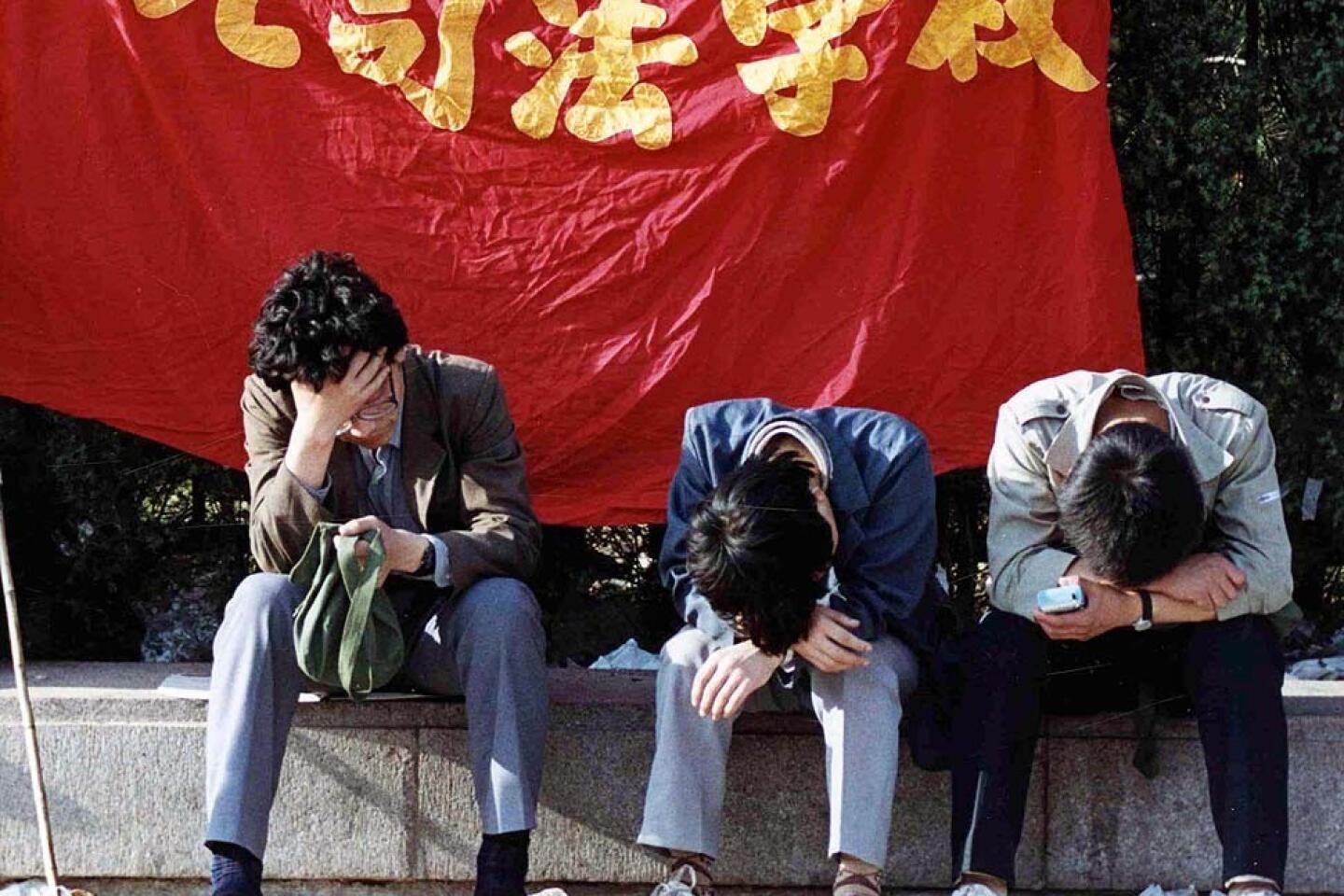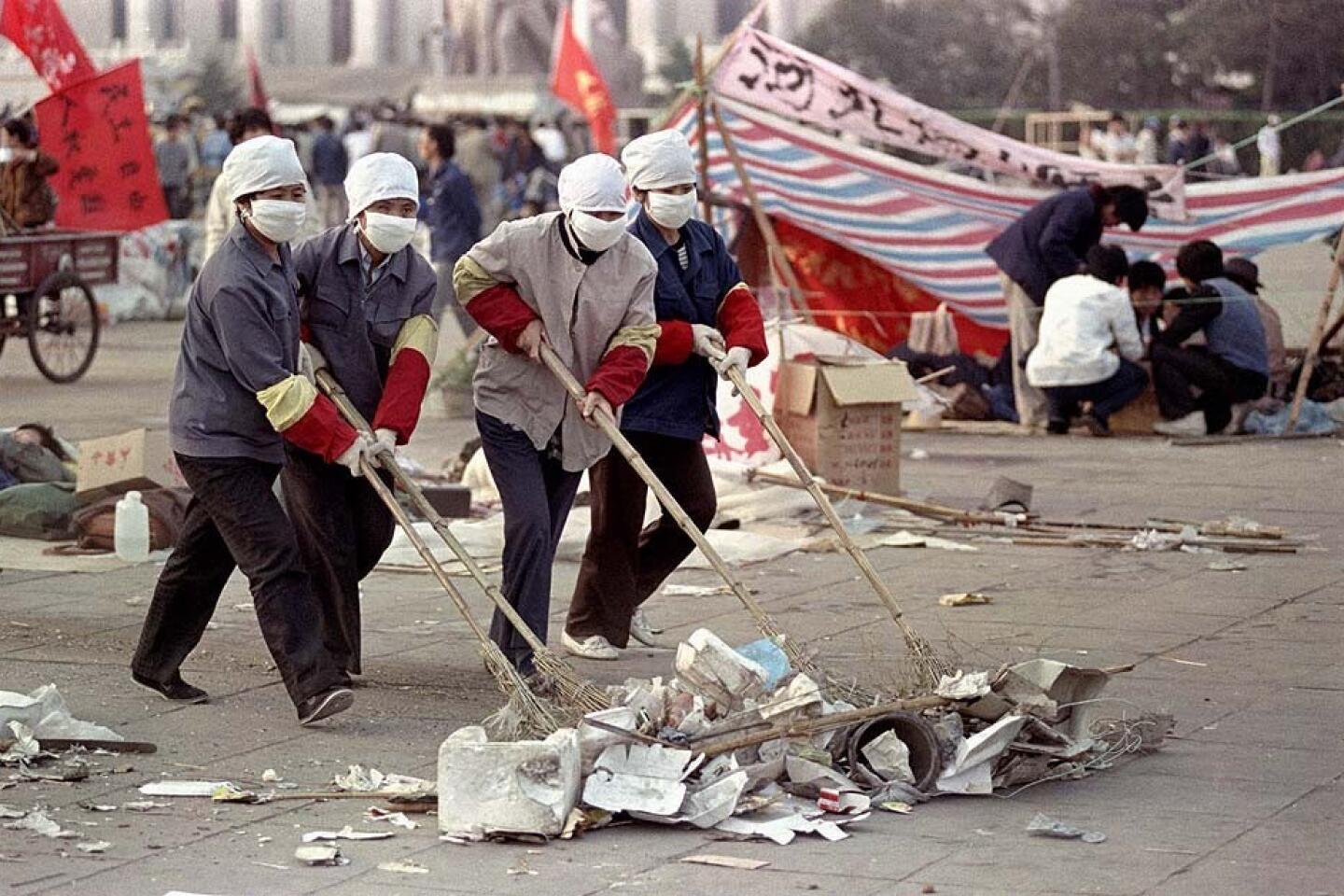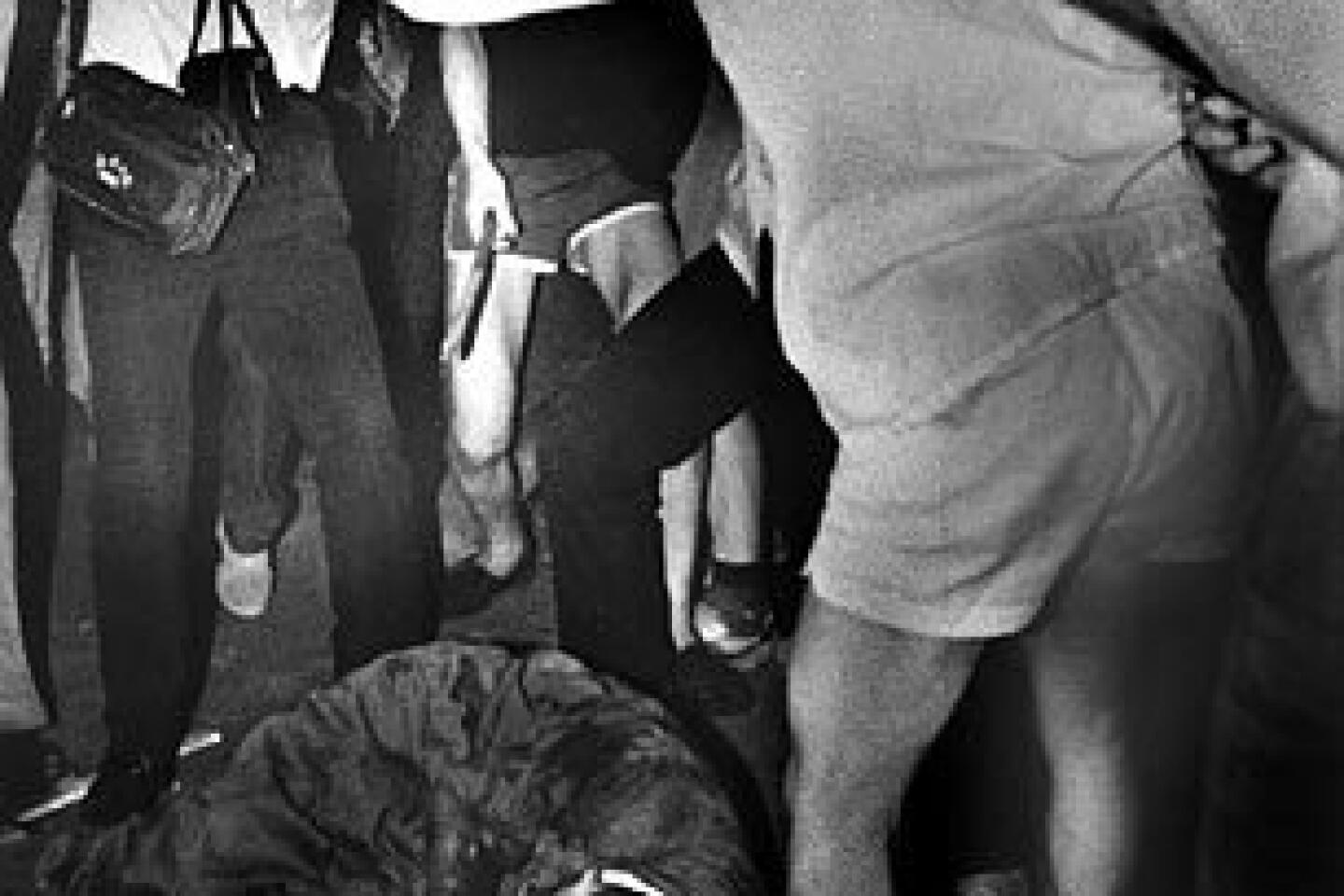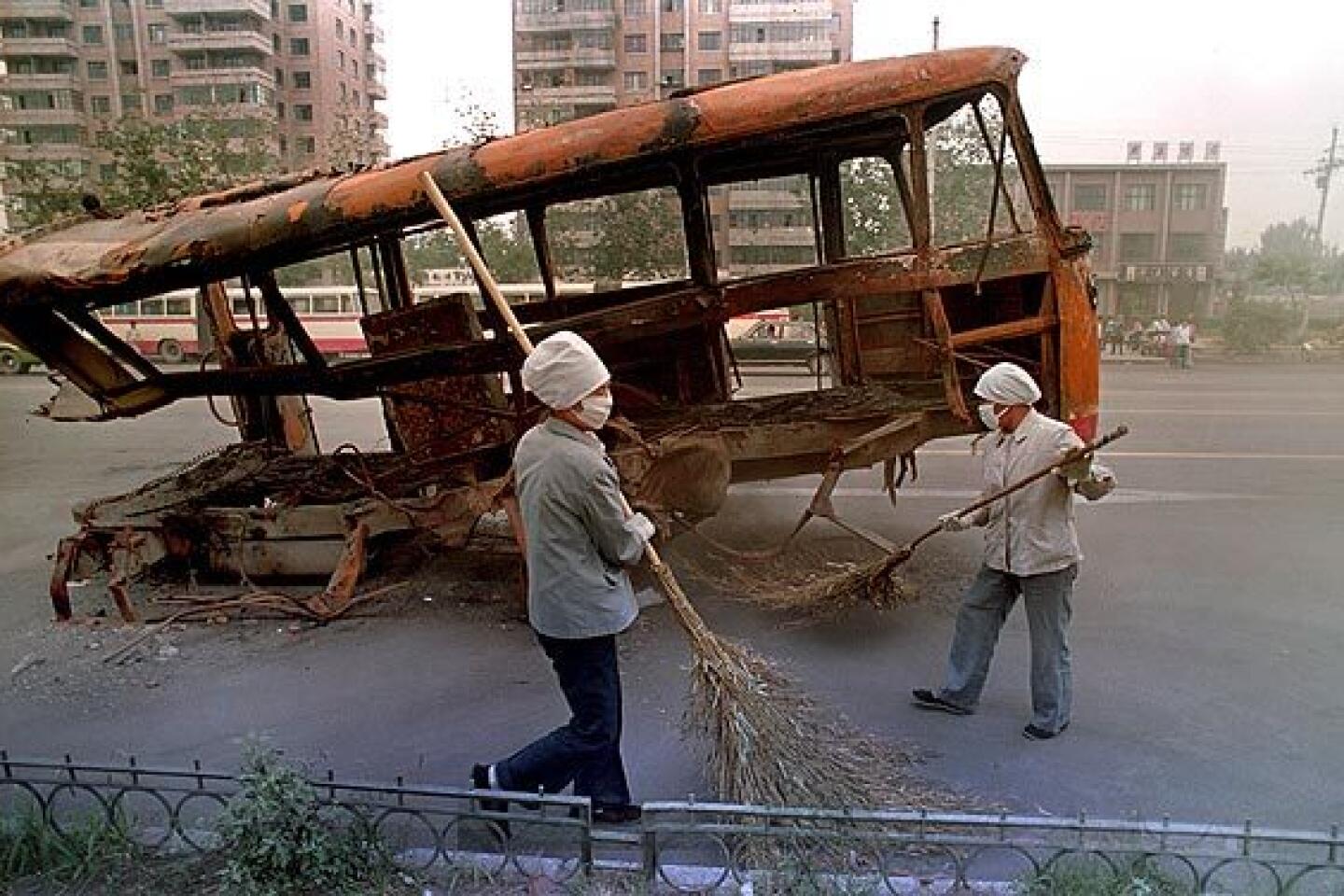From the Archives: Protests For Democracy in Tiananmen Square; Troops Fire on Beijing Crowds
- Share via
BEIJING -- Chinese troops of the People’s Liberation Army opened fire with automatic weapons early today on huge crowds of civilians in Beijing, killing at least 100 of them and perhaps many more, according to medical and diplomatic reports, in a successful effort to recapture Tian An Men Square from pro-democracy demonstrators.
At least 400 people were reported wounded.
For China, it was a fundamental turning point. The Communist Party leadership headed by the aging Deng Xiaoping made the decision that no matter how high the costs to its image at home or abroad, it had to overwhelm with a force the students and other demonstrators who had challenged the power and legitimacy of the regime.
The gunfire began shortly after midnight and continued until well after dawn. There was gunfire all over Beijing, from the central Tian An Men Square area to the areas outside the main tourist hotels to the outskirts of the city.
At times, the firing was indiscriminate. At about 5:30 a.m. today, for example, a military convoy of about 100 vehicles--including tanks, armored personnel carriers, trucks and jeeps--swept past the Beijing Hotel toward Tian An Men Square, firing at bystanders.
After they reached the square, at about 5:45 a.m., heavy automatic rifle fire could be heard from the area, which had already been subjected to several other lengthy volleys earlier in the morning.
Crowds Won’t Disperse
At noon today, the troops had cordoned off Tian An Men Square, but crowds of Chinese refused to disperse. And the shooting in the square had still not subsidied.
Every hour or so through this morning, troops fired volleys of gunfire in an apparent attempt to intimidate the crowds. Each time they did so, at least 1,000 people or more fled from the area of Tian An Men Square. Yet other Chinese kept pouring into the square, many of them to resist the troops and some of them merely to see what was happening.
There had been more than 100,000 Chinese civilians in the square to look at or join the demonstrators for democracy on a balmy Saturday evening. When the troops arrived and the firing began, many of them rushed out in panic.
“Duo si le, duo si le,” several of them shouted. “Many have died, many have died.”
It was impossible to say exactly how many were killed, but by all indications, the death toll was huge.
When one line of troops crouched and opened fire on a crowd at Tian An Men Square shortly after 3 a.m., an American reporter saw about 50 people go down.
Even after the shooting began, hundreds, perhaps a few thousand Chinese were said to have remained in the downtown area, saying they were prepared to die for the cause of democracy, the cause for which they began their series of demonstrations at Tian An Men seven weeks ago.
Guns Heard Near Newspaper
The deaths occurred not only in the center of the city, but in outlying areas. One foreign eyewitness heard firing shortly after dawn outside the compound of the Communist Party newspaper, People’s Daily, in northeastern Beijing. He was told that four people had been killed.
Hospitals in the area were so full of casualties that they scarcely had time for those who were not severely wounded.
A U.S. Embassy official said that there were about 70 dead and 300 wounded at People’s Hospital in western Beijing. Another eight dead and 80 wounded were reported at Beijing University Hospital, and there were at least seven dead at the Second Hospital of Beijing.
Casualty Estimates Vary
One American news agency, United Press International, quoting officials and staff at 10 Beijing hospitals, reported that at least 156 people had been killed and 464 others were treated for injuries. The Associated Press said one hospital doctor estimated that at least 500 people had died.
Hospital floors and downtown streets were covered with blood. In this land of makeshift transportation, the dead and wounded were carried off to ambulances and hospitals on tricycles, bicycle carts and pedicabs.
Beijing--a once-graceful capital covered over in recent years with new pastel high-rise buildings--looked this morning something like an East Asian version of Beirut, a city in the aftermath of a civil war.
Buses, trucks, jeeps, and armored personnel carriers lay burning or in ruins along major thoroughfares. Some were People’s Liberation Army vehicles destroyed by the residents of Beijing. Others had originally been used as barricades against the troops’ advance and were overrun and destroyed by tanks.
Residents Shocked, Terrified
As they saw the wreckage, residents of the city appeared shocked and terrified.
The “Goddess of Democracy,” the 30-foot sculpture built by Chinese art students and modeled on the Statue of Liberty, was ruined by Chinese tanks. An American reporter said he had been told by a Chinese eyewitness that a tank ran over and killed students trying to guard the statue in Tian An Men Square. The report could not be independently confirmed.
Shortly after 6 a.m. today, a small group of bicyclists rode down Changan Avenue towards Tian An Men Square, on their way to work or some morning recreation, apparently unaware of the shooting that had gone on for hours.
When they approached Tian An Men and witnessed the destruction, the bicyclists turned and fled.
Bloody Ending to Struggle
It was a bloody ending to the long-running battle between the Chinese regime and the pro-democracy demonstrators--a battle that the leadership found it could not win without use of lethal force.
For weeks, the regime had sought to get the demonstrators off the square but had been unable to do so. Two weeks ago, troops on the outskirts of Beijing were forced to pull back when they were blocked by massive crowds of demonstrators.
In the pre-dawn hours Saturday, People’s Liberation Army forces tried to move into the center of Beijing, but once again were stymied by resistance from the city’s population.
Several violent skirmishes erupted through the day Saturday as the armed forces sought without success to regain control of the streets of the Chinese capital.
Warned of Use of Force
By Saturday night, martial-law authorities termed the situation in Beijing “very serious” and warned that troops and police would use force against anyone resisting them. The Chinese regime said the military was engaged in “a serious political struggle that concerns the future and destiny of the state and the nation.”
The situation on the streets turned increasingly ugly through the day Saturday. Pro-democracy students were joined by workers wielding metal pipes and sticks. Some Beijing residents overturned buses and jeeps and smashed them. Saturday night, demonstrators at Tian An Men Square set fire to an army tank.
In one bloody fracas, several hundred green-uniformed PLA troops clashed Saturday night with young men wielding metal pipes and sticks just off Tian An Men Square in front of the Beijing Hotel. In another incident, about 5,000 PLA troops were surrounded and pelted with bricks, stones and bottles outside the Great Hall of the People, on the western side of the square.
The government-controlled New China News Agency said that Beijing residents besieged a military vehicle and began carting off arms from inside it. PLA troops used tear gas to recover the vehicle, the report said.
Seized Bars, Bricks
A spokesman for Beijing’s Public Security Bureau said that a crowd of about 1,000 people had seized steel bars and bricks from a local construction site.
By early today, hundreds of thousands of Beijing residents were on the streets, seeking wherever possible to block, pin down and frustrate the troops. PLA units were surrounded and halted at several points, both on the outskirts of the city and inside the city.
“This is not the People’s Army. This is the traitors’ army,” one group of young men shouted to one bewildered contingent of young soldiers seeking to enforce martial law in Beijing.
No Sign of Political Moves
There was no sign of any new effort to bring about a political settlement that might end the pro-democracy demonstrations and the intense power struggle within the Chinese Communist Party.
In an “urgent public notice” issued Saturday night, the martial-law authorities appeared to acknowledge for the first time that some of the PLA troops have been resisting orders to move against the population of Beijing.
“PLA troops must carry out the martial-law tasks as planned, and none should prevent them,” said an announcement by the authorities. “Should they be prevented, the martial-law enforcement troops will take various self-defensive measures and all means to remove the resistance.”
The martial-law announcement also asserted that some Beijing residents had seized arms and weapons and had beaten or kidnaped Chinese soldiers.
Despite the growing chaos, there was virtually no sign of any political leadership in Beijing. For all intents and purposes, the ruling Communist Party was without a spokesman.
Deng, the country’s paramount leader, remained out of sight, making at least plausible the unconfirmed reports that he has been hospitalized with a heart attack. Communist Party General Secretary Zhao Ziyang also has not been seen since May 19, when he refused to go along with the decision to impose martial law here.
On Saturday night, China’s state-controlled television network opened its nightly news show by showing Premier Li Peng reading a speech on the environment.
Li Looks Tense, Grim
Li, the unpopular hard-line leader who announced the imposition of martial law, looked tense and grim. He was also astonishingly isolated. In a manner virtually unprecedented for Chinese television, Li was shown reading his speech alone, with no Chinese leaders alongside him and no audience listening to him.
Throughout the day Saturday, the situation in the central Beijing area around Tian An Men Square grew increasingly chaotic as Chinese troops engaged in several brief, rough confrontations with the demonstrators surrounding them.
Early Saturday morning, when several thousand unarmed troops first sought to march from the outskirts of Beijing into the Square, they retreated when their path was blocked by thousands of demonstrators.
At mid-morning Saturday, a second effort by a smaller PLA contingent was similarly unsuccessful.
Troops Became Divided
According to eyewitnesses, the troops emerged from a subway stop at Jianguomen, less than a mile east of the square, and headed downtown. But they became divided on the way downtown and failed to arrive there with force strong enough to move against the pro-democracy demonstrators.
The seeming inability of the troops to gain control of Tian An Men Square on Saturday left the impression of an army with little leadership and low morale.
The Chinese soldiers were mostly young men from the countryside. Some of them were unable to speak Mandarin, the government-mandated national language. Some carried food rations whose dates showed that they were at least one or two years old.
In several instances, there were no squad or unit leaders in sight for the troops during their retreat Saturday morning.
Young Soldiers in Tears
Several witnesses saw young Chinese soldiers breaking into tears as they were confronted and berated by residents of Beijing.
“There are really only two explanations,” said one Western European diplomat. “Either the army was ordered to clear the square and was unable to do it. Or this was a deliberate attempt to undermine the leadership which declared martial law.”
By Saturday afternoon, however, the PLA troops stopped retreating and began to show a willingness to move forward against the pro-democracy demonstrators.
One contingent of about 5,000 troops emerged from the west side of the Great Hall of the People, the entrance on the opposite side of the building from Tian An Men Square.
Engaged in Tense Standoff
They were soon engaged in a tense standoff with thousands of demonstrators, who eventually surrounded the troops.
In the worst outbreak of violence up to that moment in the seven-week-long crisis, young people threw stones, bricks and bottles at the troops. In at least a few cases, an eyewitness said, troops picked up the stones and threw them back. Several demonstrators were injured.
Meanwhile, a short distance away at the entrance to Zhongnanhai, the compound where the leaders of the Chinese Communist Party live, a crowd of several thousand demonstrators gathered and stood face-to-face with steel-helmeted PLA troops standing three-deep in front of the entrance.
First Use of Tear Gas
It was outside Zhongnanhai that the troops for the first time began using tear gas. But this tactic failed to disperse the crowd, which by late Saturday afternoon extended out into the main thoroughfare.
It was a sunny, hot afternoon, and tens of thousands of Beijing residents getting out of work for the weekend pedaled their bikes through Tian An Men Square to see or take part in the pro-democracy demonstrations.
By early Saturday night, some of the confrontations began to ease. Shortly after 8:30 p.m., the troops that had earlier been surrounded behind the Great Hall of the People quietedly retreated inside the building.
According to an eyewitness, some of these troops expressed open sympathy for the demonstrators. At one point, some of the PLA troops and the Beijing residents surrounding them joined in a song, with one of the soldiers serving as musical director.
Urged to Stay Inside
The announcement by martial-law authorities Saturday night urged the population of Beijing to stay inside.
“From now on, please do not come onto the streets, and do not go to Tian An Men Square,” said the announcement. “ . . . The residents should stay at home, so as to secure the safety of your life and to avoid unnecessary losses.”
The army, however, made no effort to set up roadblocks or barricades that would keep people from venturing downtown. And throughout the evening, young men and women on bicycles streamed towards Tian An Men Square.
1:45 a.m.: Lights in Tian An Men Square are doused. Tanks and trucks move into north end of square. Shots are heard.
Crowd starts to flee east. Some run into the Forbidden City, the old Imperial Palace complex north of square.
2:30 a.m.: Troops in square fire at demonstrators, who hit the pavement. Within an hour, troops open fire again and surround the square.
3:30 a.m.: Soldiers take control of Tian An Men.
4 a.m.: Students announce over loudspeaker: “You have to give up all hope.” Then, moments later: “We can’t let any more blood flow . . . We must leave.”
Soon afterward, troops clear center of square around the Monument to the People’s Heroes.
2/
5:30 a.m.: 100-vehicle military convoy moves west along Changan Avenue past Beijing Hotel toward square. As it passes, shots are fired every few seconds at bystanders.
5:45 a.m.: Automatic rifle fire is heard for several minutes from the direction of square.
More to Read
Sign up for Essential California
The most important California stories and recommendations in your inbox every morning.
You may occasionally receive promotional content from the Los Angeles Times.






































